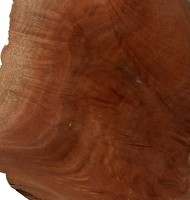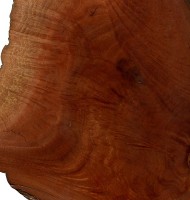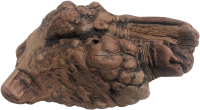 |
Common Name(s): Manzanita Scientific Name: Arctostaphylos spp. (Arctostaphylos pungens) Distribution: Shrubland regions of western North America Tree Size: 3-16 ft (1-5 m) tall, 6-10 in (15-25 cm) trunk diameter Average Dried Weight: 57.6 lbs/ft3 (920 kg/m3) Specific Gravity (Basic, 12% MC): .74, .92 Janka Hardness: 2,350 lbf (10,440 N)* *Estimated hardness based on specific gravity Modulus of Rupture: No data available Elastic Modulus: No data available Crushing Strength: No data available Shrinkage: No data available |
Color/Appearance: Heartwood is brownish red, sometimes with a bright orange hue. Sapwood is a pale off-white to light brown; clearly distinguished from heartwood, but not sharply demarcated. Burls and wild or swirled grain is common.
Grain/Texture: Manzanita has a fine, uniform texture with a good natural luster.
Endgrain: No data available.
Rot Resistance: No official data available, though anecdotal reports suggest that the wood is very durable and resistant to decay.
Workability: Manzanita can be difficult to machine because the tree (usually a shrub) tends to have so many defects and irregular grain. Small pieces with straight, clear grain are relatively easy to work when compared to woods of similar density. Manzanita tends to check and split if not dried with care. Turns and finishes superbly.
Odor: No characteristic odor.
Allergies/Toxicity: Besides the standard health risks associated with any type of wood dust, no further health reactions have been associated with Manzanita. See the articles Wood Allergies and Toxicity and Wood Dust Safety for more information.
Pricing/Availability: Manzanita is typically only a small shrub or tree, and supplies are limited to hobbyist demand. Root burls are the most common form of Manzanita offered for sale. Very small boards and turning blanks are also available occasionally. Given Manzanita’s small size, and special processing requirements, prices are understandably high.
Sustainability: This wood species is not listed in the CITES Appendices or on the IUCN Red List of Threatened Species.
Common Uses: Decorative slabs, small boxes, turned objects, and other small, specialty wood items.
Comments: The gnarled and twisted branches of Manzanita make it a favorite wood for bird perches and aquarium driftwood. However, its form as a shrub generally means that its beautiful wood is only straight enough and long enough to be used in very small projects.
None available.
None available.







There is lots of manzanita in and around my county,I have actually used it for custom hand carved smoking pipes,it does not burn up as much as say hickory and other hard woods if used,I use the shape of the wood to dictate how the pipe will look in the end
I found drying and curing Manzanita quite simple. Get a gallon and a half boiling water, mix in 1.75 oz gorilla glue. Boil only 2-3 mins. Mix thouroghly. After project is done, use heat proof glooves, use a sponge and wipe down. Will dry rather quickly. Keep water in pot mid warm. Apply several coats until desired finish. Not only prevents cracking but also strengthes an already dense wood. Also use clear gorilla glue.
Is it safe to save red color of bark ?
I would like to make a wall decor from manzanita wood and don’t know how to save color.
Manzanita that has died slowly, when under the yearly increasing shade of larger trees, or the undergrowth in a stand of manzanita, will have no cracks. The leaves need ‘full sun’ so it’s common for half of the manzanita, underneath, to be dead and uncracked, since the overgrowth happened slowly and the undergrowth died a little portion of stalk at a time. It can take years for a single stalk to die.
#1 – I’m a woodworker (hobby type) #2 – I live on 2 acres with mostly manzanita, both live growing and dead still standing. All sizes from twigs up to about 6″-8″ diameter. Lengths from short to aprox. 2′-3′ straight sections. Lots of possible project sizes. But, I have the same problem as everyone else. It cracks when drying. I’ve tried sealing the cut ends with melted wax and drying them inside for slower drying. After about 2 weeks the cracks still show up lengthwise on all sizes. How do you dry this “nasty” wood and eliminate most of the… Read more »
did you ever get any answers? I’m going to start experimenting with it but looking for suggestions, at least ways that don’t work. Do you know what the moisture content was of the wood when you started drying it?
Have you tried soaking them in denatured alcohol? You submerge them overnight, then take them out and let them dry per your usual routine.
BTW, I’m not sure what you mean about “drying them inside for slower drying.” Usually indoors there’s lower humidity, which would mean that the wood would dry faster.
You might want to try boiling the wood. https://www.woodturningvideosplus.com/boiling-green-wood.html
Too late to help you, but I’ve had good luck drying manzanita trunk wood by promptly cutting down the pith line on a bandsaw in two planes (basically quartering it, but the quarters are uneven because the pith isn’t centered) and waxing it. If you leave the trunk intact it will check badly. You have to relieve the stress of drying by cutting it in advance. The good news is that manzanita typically grows strongly to one side of the pith line, so you could end up with three-quarters of the wood in one chunk of you think out how… Read more »
This is the appropriate way to handle it. Cutting down the pith line solves the problem. You may still get some checking on thinner pieces, but for thicker pieces with some mass to them, waxing will prevent this, and I’ve actually found it checks less than many other woods.
Wax is exactly what I was thinking for this project! I need to know how to cut back a patch of manzanita and keep it gone. I have pruned this patch twice, it growing back in thicker each time
The only way to stop it growing back is to dig up the roots. After heavy rains is the easiest time to remove. We usually throw a chain around the base and pull it up with a four wheel drive. If that’s not an option, cut it as low as you can and leave a flat top on it. Make a deep cut straight down with the tip of your chain saw or Drill a 1/2 inch hole straight down 3-4 inches deep and pour in an ounce or two of deisel or gasoline.
Try soaking in radiator fluid. The water in the wood is replaced by the glycerine in the radiator fluid that won’t evaporate. Your manz is stablized